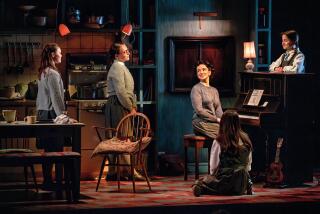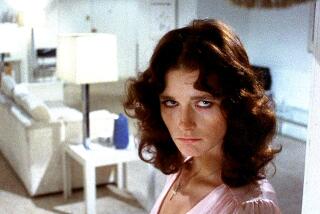MOVIE REVIEW : De Palma Damps the ‘Bonfire’ : Movies: A rich novel is turned into an overstated, cartooned film for dullards.
- Share via
Brian De Palma opens his calamitous version of Tom Wolfe’s dense novel “The Bonfire of the Vanities” (at selected theaters) with a glittering, dusk-through-dawn shot of Manhattan from a point of view of a Chrysler Building gargoyle.
It’s not the last of the movie’s visual excitement; unfortunately, it’s not the last of its monsters either. In a disastrous misjudgment, De Palma decided that Wolfe’s panoramic morality play about a privileged WASP overreacher needed pointing up for dullards like us in a movie audience.
So what was rich, journalistic and precisely observed is now overstated, under-textured and cartooned, in playwright/screenwriter Michael Cristofer’s witless screenplay. Certainly Wolfe’s canvas might lend itself to a broad approach, but broad like “Dr. Strangelove,” not broad like the Three Stooges.
With the exception of the three principals--a game but miscast Tom Hanks as the patrician broker Sherman McCoy, Melanie Griffith as his mistress, Maria Ruskin, and Bruce Willis as the boozy journalist responsible for Sherman’s plummet from power--De Palma has packed the screen wall-to-wall with harpies, gargoyles, grotesques and caricatures. He’s also made Wolfe’s memorable Jewish judge, Myron Kovitsky, black, the better for Morgan Freeman to deliver the movie’s stern but soothing homilies to an almost-rioting black courtroom audience.
Both De Palma’s tamperings and his approach may infuriate those who savored the book’s brilliant high comedy, while the movie’s callow vision of life among the haves--and have-nots--is enough to make non-”Bonfire” readers wonder why anyone would have read 10 pages of anything this sophomoric, much less 659 of them.
In rough outline, Hanks’ Sherman McCoy feels himself a true Master of the Universe, one of those Norse-god-like plastic toys, as he contemplates his assets: top-dog position at a hallowed Wall Street brokerage house, a Park Avenue apartment and a wife, daughter and mistress.
All will be ripped away from him after a hit-and-run accident in the Bronx, when Sherman’s Mercedes apparently hits and injures a young black man at a dark freeway on-ramp. Conscience-stricken, Sherman wants to report it, but since the also-married Maria is a clandestine fellow passenger, she persuades him not to.
When the victim falls into a coma and the car’s ownership is traced, Sherman becomes the center of a political cat’s cradle reaching from the Bronx to Wall Street to Park Avenue.
The Bronx D.A. (F. Murray Abraham) wants Sherman’s WASP neck, the better to run for mayor. Harlem’s self-styled religious leader, Rev. Bacon (John Hancock), spokesman for the young victim’s mother (Mary Alice), wants Sherman as an example of white arrogance. His too-chic and too-thin wife Judy (Kim Cattrall), the injured party, wants Sherman’s child and his bank account. And Maria wants whatever moving part is left over.
While Sherman’s term of office as one of Manhattan’s Masters was relatively short-lived in the novel, it was written with such authority that his patrician family, his business savvy and his enormous success had real believability and meaning. By introducing Sherman, as De Palma does, just as his foot hits the roller skate at the top of the stairs, we have no sense of what he stands to lose. Certainly the loss of that wife or that child would come under the heading of a blessing. And in spite of Hanks’ touch with both the film’s comedy and pathos, and Sherman’s birthright isolation from the real world, Hanks still seems too boyishly untried, not world-worn enough.
In much the same vein as Sidney Lumet’s insightful “Q&A;,” Wolfe suggested that shaky ethnic alliances had held the city together for generations and that they might be fraying out in front of New Yorkers’ oblivious noses. The movie goes for the fury without the artful distinctions among these warring factions.
In 1987, Wolfe’s book was prescient, before Howard Beach, before Tawana Brawley, before even the yo-yo-ing fortunes of The Donald. When Wolfe drew a character like Rev. Bacon and his theory of ghetto “steam control,” Bacon was a rich and complex key to the city’s ferment.
Now however, Bacon is simply an easy send-up of Al Sharpton, never seen without his back-up gospel chorus of five women in gold satin robes. He’s been transformed the same way that Peter Fallow, the book’s dim alcoholic English tabloid hack, has been turned into the wryly American Bruce Willis--by taking all the good stuff out. And so it goes, character by character, throughout the movie.
Willis, for the relatively little that’s demanded of him in terms of characterization, is very good. If you think his amazing physical business at the opening is easy, think again. Griffith, who’s able to capture every nuance of Maria’s devious mind and every inch of her stunning body, is equally fine. (The film’s R rating is for strong language.) In contrast, most of the rest of the cast has been cattle-prodded into wretched excess, beginning with Abraham and Cattrall.
De Palma has pushed the look of his movie into cartoony excess too, so that we are forever peering at characters from the jowls up or from the bald spot down or as they are goggling into the camera like TV pitchman Ernest.
This can hardly be laid at the door of the splendid cameraman Vilmos Zsigmond, who is just giving the boss what he wants. To be fair, De Palma also wanted the amazing five-minute opening action sequence that introduces Willis’ Peter Fallow, arriving dead drunk for his awards ceremony.
As Fallow is poured out of a limo, through the entrails of the World Trade Center, out of his jacket, into his tuxedo and up on to the awards dinner platform, he is caught in a tour-de-force of Steadicam sinuousness that may one-up a similarly fluid sequence in “GoodFellas.”
In the “GoodFellas” sequence, director Martin Scorsese used one long, uninterrupted shot, winding through a nightclub’s backstage off-limits to show us his young gangster’s comic worldliness; it was the character showing off, not the director. “Bonfire’s” opening sequence is drop-dead but gratuitous, a hint of what is to come.
‘Bonfire of the Vanities’
Tom Hanks: Sherman McCoy
Bruce Willis: Peter Fallow
Melanie Griffith: Maria Ruskin
Kim Cattrall: Judy McCoy
Morgan Freeman: Judge White
Saul Rubinek: Jed Kramer
F. Murray Abraham: Weiss
A Warner Bros. release. Executive producers Peter Guber, Jon Peters. Co-producer Fred Caruso. Producer, director Brian De Palma. Screenplay Michael Cristofer, based on the novel by Tom Wolfe. Camera Vilmos Zsigmond. Music Dave Grusin. Editors David Ray, Bill Pankow. Production design Richard Sylbert. Art director Peter Lansdown Smith, Greg Bolton. Set design Richard Berge, Robert Maddy, Nick Navarro. Set decoration Joe Mitchell, Justin Scoppa. Costumes Ann Roth. Sound Les Lazarowitz, James Tanenbaum. Running time: 2 hour, 5 minutes.
MPAA-rated: R (strong language).
More to Read
Only good movies
Get the Indie Focus newsletter, Mark Olsen's weekly guide to the world of cinema.
You may occasionally receive promotional content from the Los Angeles Times.










